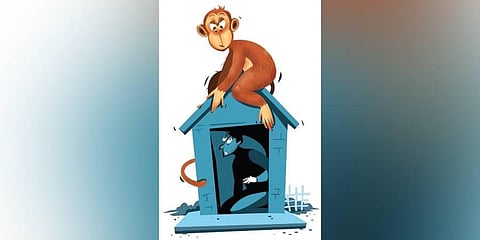

BENGALURU: Malleswaram is being invaded. It’s an invasion by invaders attempting reclamation of the land that once was their home. And there’s nothing much the residents can do about it. But this invasion is unlike the Russian one in Ukraine. It involves no tanks, artillery, machine guns or missiles — just the invaders, with not even a shred of clothing on them to call it a uniform. Recently, a resident standing on his balcony noticed what seemed like a rope hanging from the chajja above, and instinctively grabbed it. To his utter shock the rope withdrew itself, and in its place came the face of its bewildered owner, a huge monkey with its fangs bared and shrieking at the man in his face. Shocked out of his wits, the resident took to his heels in panic, hurriedly closing the balcony door from inside and screaming alerts to his family members and neighbours to lock all doors and windows.
An entire troop of monkeys had descended on the building. Some residents caught unawares reported being “held hostage” by the simians in their own homes. Neatly kept fruits in bowls vanished, leaving peels and leftovers strewn all over the floor, even as the inhabitants tried every trick under the roof to lure the monkeys out. Some succeeded, some didn’t. The latter had more interesting tales of destruction to narrate than the former, who only boasted about the methods used to get the monkeys out of their homes. Troops of monkeys are ruling over Malleswaram, and the current invasion is just one among many that have occurred in this area. Just a few decades ago, Malleswaram was a forested area.
This once-forested area is home to the famous Kadu Malleshwara Temple. ‘Kadu’ means ‘forest’ in Kannada, indicating that Malleswaram was once a forest. The temple, built in the 17th century by the Maratha king Shivaji Bhonsle’s brother Venkoji, was once surrounded by a thick forest which was the abode of the monkeys. With devotees thronging the temple with offerings of fruits and other edibles, it turned out to be a major attraction for monkeys who generously received their share. The forests are now replaced by concrete structures.
Malleswaram — planned in the dying years of the 19th century following the Great Plague — still retains a fairly thick green cover. But the expanding human habitation and increased residential and commercial activities displaced the simians. Humans have an inherent capability to accomplish this feat — displace another species, if not completely render it extinct. William McGuire Bryson, an American-British author on topics including travel, English language and science, in his book A Short History of Almost Everything, cites University of Chicago palaeontologist David Raup, who estimated that the average rate of extinction of species throughout biological history on earth due to human interference is one species every four years. It is also estimated separately that up to 90 per cent of the species that ever lived on earth are now extinct, and that the rate of extinction speeded up drastically with the arrival of humans. The monkeys will not go that way though. They are resilient.
That resilience is on display today. They will not give up. In June 2021, the Karnataka High Court directed the Bruhat Bengaluru Mahanagara Palike (BBMP) and the forest department to devise a plan to shift monkeys back to their natural habitat. How far that will succeed is anybody’s guess. This used to be their natural habitat once upon a time. The Russians will go back home from Ukraine, but the monkeys will not from Malleswaram. The invasions will continue, and Malleswaramites will have to live with them.